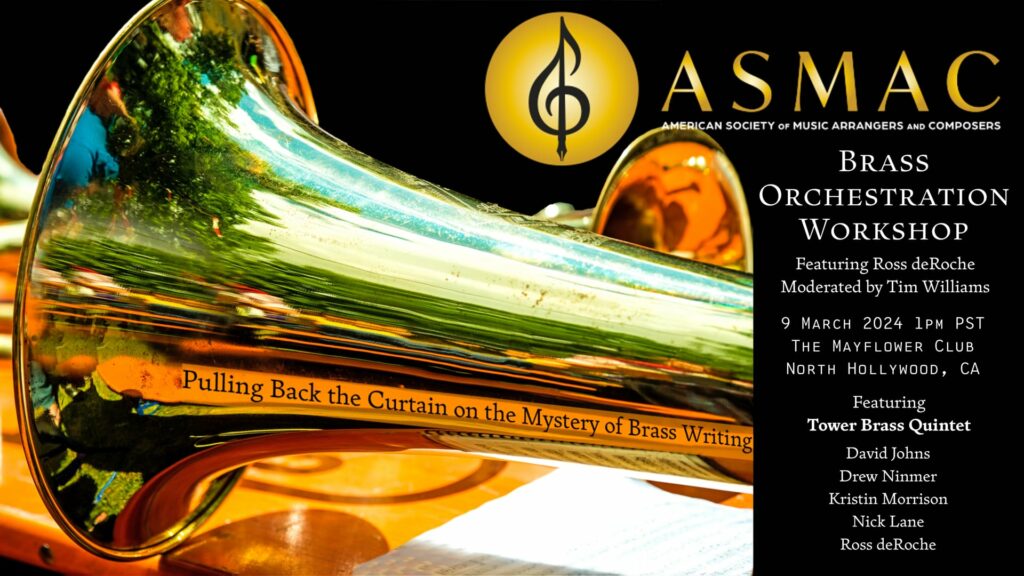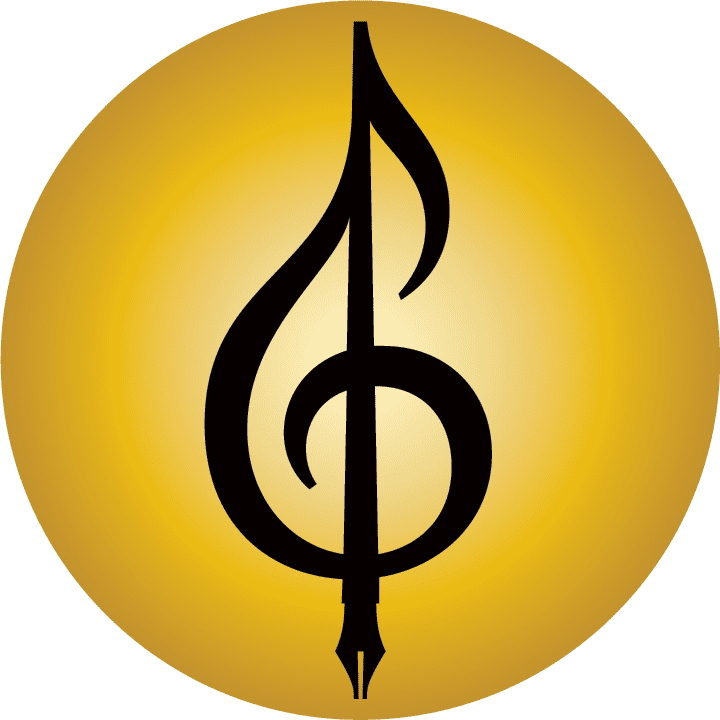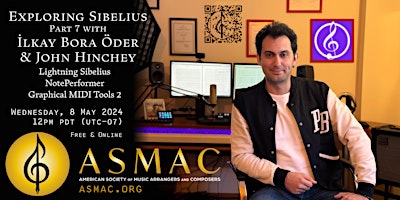 Event: Brass Orchestration Workshop: Pulling Back the Curtain on the Mystery of Brass Writing
Event: Brass Orchestration Workshop: Pulling Back the Curtain on the Mystery of Brass Writing
Date: Saturday, March 9, 2024
Location: The Mayflower Club, North Hollywood, CA, USA (in-person) and online via Zoom Platform.
ASMAC members can re-watch the 2.5-hour event video.
Esteemed Guests:
Tower Brass Quintet:
- David Johns (Trumpet)
- Drew Ninmer (Trumpet)
- Kristin Morrison (French Horn)
- Nick Lane (Trombone)
- Ross deRoche (Tuba)
Moderator: Tim Williams
The event focused mainly on unraveling the intricacies of brass orchestration through a captivating live demonstration and engaging discussion led by talented professionals who shape the brass soundscape across film, TV, video games, and concert music. Attendees delved into diverse topics, including:
- Orchestration techniques
- Instrument combinations
- Utilization of mutes
- Articulations exploration
- Brass ranges and their applications
- Doubles in brass instrumentation
- Practical and impractical usage considerations
- Suggested references
We had a chance to meet Ross deRoche, who is a talented studio musician with over 35 years of experience. Ross can attribute his expertise to being a music copyist, supervisor, and contractor. His proficiency in score supervision ensures the effective integration of music into visual media. Known for his skills on the bass trombone and tuba, he has contributed to numerous motion pictures, such as The Day After Tomorrow (2004), 2012 (2009), Stealth (2005), Watchmen (2009), Guardians of the Galaxy Vols. 1-2 (2014-2017), White House Down (2013), Mr. & Mrs. Smith (2005), 300 (2009), the comedy This is the End (2013), Deadpool 2 (2018), Independence Day-Resurgence (2016), and one of James Horner’s last projects, The 33 (2015). His company, deRoche Music, Inc., has overseen score supervision for acclaimed films like The Revenant (2015) and Birdman (2014), in addition to coordinating and supervising the opening and closing ceremonies of the 1996 Atlanta and 2002 Salt Lake City Olympic games. In television, Ross has contributed to iconic series such as St. Elsewhere (1982-88), Lonesome Dove (1989), and SWAT (2017). He is the score supervisor for the symphony tour of the very popular Irish vocal group “Celtic Woman.” Ross is also at the forefront of video game orchestral soundtracks, contributing to titles such as Call of Duty: Black Ops II, III, IV, and Cold War, Bioshock 1-2, God of War, Mass Effect 2, Demon Stone, Eragon, the entire Harry Potter series, Advent Rising, Myst IV, Destroy All Humans 1-2, and Jade Empire. His involvement in the “Video Games Live” tour produced by Tommy Tallarico shows his diverse range of talents and dedication to music.
The person who moderated the event, along with other esteemed musicians of the Tower Brass Quintet, is Timothy Williams, a multi-award-winning composer. His best-known works are Pearl (2022), Guardians of the Galaxy Vol. 1-2 (2014-17), and Brightburn (2019). The score for Pearl won Best Horror Score in the Movie Music UK Awards and was nominated for Best Horror Score in the International Movie Music Awards. Tim also scored We Summon The Darkness (2019), Wild Horses (2015), Red Sky (2014), Beyond All Boundaries (2009), Deadpool 2 (2018), 300 (2009), I.T. (2016), Watchmen (2009), Super (2010), Sucker Punch (2011), and The Spy Who Dumped Me (2018). Caroline Lindy’s film Your Monster (2024) is one of his most recent releases, along with Founder’s Day (2023), directed by Erik Bloomquist; Gringa (2023); and Finding You (2021), distributed by Roadside Attractions. He also wrote additional music for Get Out! (2017), which won the Academy Award and Golden Globe. His television work includes co-scoring Netflix/Sony Animation’s Agent Elvis (2023) and AMC/Shudder’s Creepshow (2019), Disney’s Piney: The Lonesome Pine (2019), and additional music on Fox’s The Exorcist (S2, 2017), and Comedy Network’s Sym-Bionic Titan (2010-11).
During the event, several scores were showcased, including the brass section of Black Tears from Guardians of the Galaxy, composed by Timothy Williams, and Milton Nelson’s Christmas Song. Additionally, attendees received numerous useful tips on how to write specifically for the brass section to achieve the best sound and cater to the needs of the musicians who will perform a particular piece.
When composing for brass instruments, it’s essential to consider phrasing and the musicians’ ability to take breaths. Melodies written in the high range require more breaks due to the increased air pressure needed for high-pitched sounds. Moreover, participants gained valuable knowledge about which instruments produce different colors in each register. For instance, trumpets and trombones typically yield a harsh, cutting sound, whereas tubas and horns offer a warmer tone and are better suited for blending with each other. One of the most interesting and practical aspects of the workshop was when each musician presented their instrument’s full range and demonstrated the use of mutes, providing detailed descriptions of their effects.
Trumpet mutes:
- Straight mute is the most commonly used type of mute for the trumpet. It is a cone-shaped device made of metal or plastic that fits into the trumpet’s bell. When inserted, the straight mute produces a brighter and more focused sound by partially damping the vibrations of the instrument’s bell.
- Cup mute resembles straight mute in shape but features a cup-like extension at the end. This design creates a warmer, mellower tone with a more subdued quality compared to the straight mute. Cup mutes are often used in jazz and ballad settings to achieve a smoother, more intimate sound.
- Harmon mute (or Wah-wah mute) is distinguishable by its small stem and hollow, cup-shaped body covered by a metal or cork plunger. By adjusting the plunger’s position within the mute, trumpet players can manipulate the instrument’s sound to create a distinctive “wah-wah” effect. The harmon mute produces a nasally muted tone ideal for jazz and certain orchestral passages.
- Bucket mute consists of a cylindrical metal or plastic tube with a fabric or felt lining that resembles a small bucket. When placed in the trumpet’s bell, the bucket mute produces a dark, veiled sound reminiscent of a distant trumpet. This muted timbre is often utilized in jazz and big band music for its unique color.
- Plunger Mute is similar in appearance to the harmon mute. The plunger mute is a versatile accessory commonly associated with jazz trumpet playing. Unlike the harmon mute, which features a fixed plunger, the plunger mute allows players to manually manipulate the plunger’s position to alter the instrument’s sound dynamically. By covering and uncovering the bell with the plunger, trumpet players can produce a range of expressive effects, including growls and smears.
French horn mutes:
- Stopping mute is also known as a hand or hand-stopping technique; this is a fundamental mute for the French horn. Instead of a physical device, the stopping mute involves the player’s hand being inserted into the bell of the horn to alter the instrument’s sound. By varying the size and shape of the hand’s position, players can produce a range of muted tones, including a muted, warm timbre used in various classical and contemporary compositions.
- Straight mute for the French horn is similar in design to the straight mute used for the trumpet. It is a cone-shaped device made of metal or plastic that fits into the bell of the horn. When inserted, the straight mute dampens the vibrations of the bell, resulting in a brighter, more focused sound ideal for certain orchestral passages and solo performances.
Tuba mutes:
- Straight mute is also similar to the straight mutes used with trumpets and French horns; the straight mute for the tuba is a cone-shaped device inserted into the instrument’s bell. It serves to alter the tuba’s sound by partially damping the vibrations, resulting in a brighter and more focused tone. Straight mutes for tubas are commonly used in various musical genres, including orchestral, jazz, and brass band settings.
- Practice mutes are designed to significantly reduce the volume of the instrument, making it quieter for practicing without disturbing others. It typically features a heavy construction with dense materials to absorb sound effectively while maintaining the instrument’s pitch and response. Practice mutes are not used for performances; they allow tuba players to practice in environments where loud volumes are not feasible, such as apartments or shared living spaces.
During the brass workshop event, attendees were treated to a fascinating array of instruments that are usually not encountered in a traditional orchestral setting. Among these rarities were the cimbasso, piccolo trumpet, and Wagner tuba (Wagnertuben or Tuben). Presented with meticulous attention to detail, the discussion illuminated the distinctive characteristics, clefs, and intriguing applications of these instruments within an orchestral context.
Take, for instance, the Piccolo trumpet, capable of producing quiet sounds in the higher register, in contrast to its larger counterpart, the standard trumpet, which typically projects louder sounds in higher registers. Such insight into the diverse sound possibilities of these instruments confirmed the audience’s appreciation for the depth and diversity of the brass section. Additionally, attendees had a chance to explore the customary orchestral arrangements for brass ensembles, which commonly adhere to the triad concept, comprising:
- 3 trumpets,
- 2 or 3 horns,
- 3 trombones,
- 1 tuba.
The event, held both online and in person, proved to be an exceptionally engaging and educational experience. Participants were provided with valuable insights into brass arrangements and orchestration techniques, fostering a dynamic exchange of knowledge. Throughout the event, attendees had the opportunity to pose questions, further enhancing their understanding of the subject matter.
In addition to practical demonstrations of various instruments, a wealth of educational materials was shared. These included books such as The Complete Arranger by Sammy Nestico, Inside the Score by Rayburn Wright, and The Contemporary Arranger by Don Sebesky. These resources cover arranging and orchestration for brass sections and other instruments, enriching participants’ understanding of the craft.



